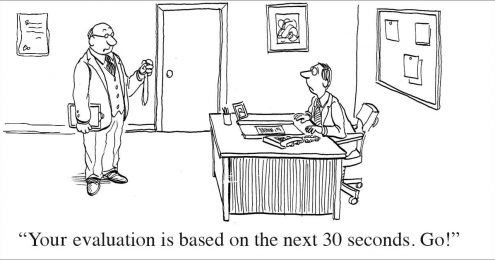I have a question for you.
Why do you think it is that so many nonprofit boards fall down on one of their biggest single responsibilities they have as board members? The annual performance review of their Executive Director.
You know I’m right. I see clients all the time, and I’ll ask, “When did you last have your performance review?”
“Review?”
“When did you last have your performance review?”
“Three years … five … seven. I’m not sure.”
“When did you last have your performance review?”
“It was a cup of coffee, I think, a year ago with the board share. He said I was doing a good job, thought I should do more fundraising.”
Yeah. That’s how it works in far too many organizations. When any list you look at, the top three responsibilities of a board member will always include hiring, evaluating, and, if you have to, firing your Executive Director.
In this video, I’d like to talk a little bit about what I think gets in the way, what the implications are of that, and then, I have an idea of a simple process that you can institute ASAP that can get you on your way to fulfilling the responsibility you have as board members.
What gets in the way? I think probably the biggest thing is that it feels really overwhelming. “I’m a board chair. I’m going to have to take the lead on it. I have way too much to do. It just feels big.”
Secondly, there’s a problem with the how. “I don’t know how to do it. Do I have to create a survey, does everybody have to fill it out? Does all the board have to fill it out, how about the staff? How about external stakeholders? What am I doing? I don’t know this stuff.”
Or this one, “Oh my gosh, we just love our Executive Director and we don’t really have any need. She knows, we know.”
No, no. No, no, no, no, no.
And then, we have the last one, which is an Executive Director that is somehow intimidating to the board. Yes, this happens. Happens with founders, but it happens with longs and strongs, happens a lot.
I have an example. I remember sitting and talking to someone on a board and they said, “I was going to put what I really thought in the evaluation, but the truth of the matter is, I was afraid that she was going to decipher my handwriting.” Really?
It is time for boards to take this responsibility seriously. Please evaluate your Executive Director and do so with respect, do it professionally, do it formally, and do it honestly. Because here are the implications. If you don’t do that, if I have to bug you to get a performance evaluation, how does that make me feel? How would you feel in your day job as a board member if you didn’t have an annual performance review?
Actually, you’d be furious because your comp was going to be tied to it. And yet, we let Executive Directors go unevaluated.
We disrespect them when we don’t evaluate them. We don’t give them the opportunity to grow as leaders because we don’t provide them with any professional development, any constructive feedback. If you are a large organization and you have a fairly big staff, you’re missing the opportunity to hear from them about your Executive Director. And there could be something that you really need to hear and it may be the only mechanism that staff member has to share that information with the board.
But the bottom line is, the biggest implication you have is you are sending a big, fat message to your Executive Director that you don’t value the process. The extension, you don’t value them. This may be the last message you want to communicate, but if you forget the anniversary date, if you bumble your way through some kind of process, you can end up doing more harm than good.
I want to leave you with this last idea. I’m going to give you this sort of the top line of it, maybe it will make it feel less overwhelming, less daunting. Take the job description you worked so hard to create when you hired your Executive Director. Get a copy to your ED and a copy to maybe two other people besides the board chair. Okay? Maybe there’s a group of three people, maybe it could be the whole executive committee, but I’m going to go with three people.
Using the job responsibilities, especially if you didn’t have goals set for the previous year, using job responsibilities, each of you use the same template and you put in pluses, you put in deltas, you put examples of the pluses and examples of the deltas. You also look at the competencies, diplomacy, playing nice in the sandbox, all those sort of intangibles, and talk about those too, but use the same template, it’s called your job description.
And then, you synthesize the trio or the executive committee’s information and the board chair sits down and looks at the self-evaluation against that synthesis. Out of that, you have a conversation, which leads to the Executive dDirector preparing a set of goals for the year that also include goals for professional development to address anything that came up in the interview … in the evaluation.
There are lots and lots of very complicated ways to do evaluations. If you’re not doing one and you just really need to do one because the anniversary date is coming up, please do not hesitate, take this idea, use it, and evaluate your Executive Director.
I’m soon writing a blog post with a little bit more detail about this simple method for evaluating your Executive Director. In fact, by the time you watch this video, it may already have been posted at joangarry.com, but for your convenience, we have the link below as well.
The bottom line here is, your highest performing people get professional, honest, formal evaluations every year. They deserve it. They deserve to know what’s working, what could be working better. They deserve to hear that. It’s part of your job as a board member to take on this task and make sure that your executive director gets an annual performance review. It’s that simple.


